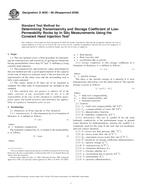Potřebujeme váš souhlas k využití jednotlivých dat, aby se vám mimo jiné mohly ukazovat informace týkající se vašich zájmů. Souhlas udělíte kliknutím na tlačítko „OK“.
ASTM D4630-96(2008)
Standard Test Method for Determining Transmissivity and Storage Coefficient of Low-Permeability Rocks by In Situ Measurements Using the Constant Head Injection Test (Withdrawn 2017)
Automaticky přeložený název:
Standardní zkušební metoda pro stanovení propustnosti a skladové Koeficient Low-propustnost hornin in situ měření pomocí Konstantní Head Injection test
NORMA vydána dne 15.9.2008
Informace o normě:
Označení normy: ASTM D4630-96(2008)
Poznámka: NEPLATNÁ
Datum vydání normy: 15.9.2008
Kód zboží: NS-27957
Počet stran: 6
Přibližná hmotnost: 18 g (0.04 liber)
Země: Americká technická norma
Kategorie: Technické normy ASTM
Kategorie - podobné normy:
Anotace textu normy ASTM D4630-96(2008) :
Keywords:
Fault zones, Field testing--rock, Flow and flow rate--soil/rock/related materials, Permeability--soil/rock, Pressure testing--rock, Rock materials/properties/analysis, Saturation, Storativity, Transmissivity and reflectivity, Viscosity--rock, Water analysis, Water saturation, Borehole drilling, Constant head testing, Discontinuities--rock, ICS Number Code 07.060 (Geology. Meteorology. Hydrology)
Doplňující informace
| Significance and Use |
|
Test Method—The constant pressure injection test method is used to determine the transmissivity and storativity of low-permeability formations surrounding packed-off intervals. Advantages of the method are: (1) it avoids the effect of well-bore storage, (2) it may be employed over a wide range of rock mass permeabilities, and (3) it is considerably shorter in duration than the conventional pump and slug tests used in more permeable rocks. Analysis—The transient water flow rate data obtained using the suggested test method are evaluated by the curve-matching technique described by Jacob and Lohman (1) and extended to analysis of single fractures by Doe et al. (2). If the water flow rate attains steady state, it may be used to calculate the transmissivity of the test interval (3). Units: Conversions—The permeability of a formation is often expressed in terms of the unit darcy. A porous medium has a permeability of 1 darcy when a fluid of viscosity 1 cp (1 mPa·s) flows through it at a rate of 1 cm3/s (10−6 m3/s)/1 cm2 (10−4 m2) cross-sectional area at a pressure differential of 1 atm (101.4 kPa)/1 cm (10 mm) of length. One darcy corresponds to 0.987 μm2. For water as the flowing fluid at 20°C, a hydraulic conductivity of 9.66 μm/s corresponds to a permeability of 1 darcy. |
| 1. Scope |
|
1.1 This test method covers a field procedure for determining the transmissivity and storativity of geological formations having permeabilities lower than 10−3 μm2 (1 millidarcy) using constant head injection. 1.2 The transmissivity and storativity values determined by this test method provide a good approximation of the capacity of the zone of interest to transmit water, if the test intervals are representative of the entire zone and the surrounding rock is fully water-saturated. 1.3 The values stated in SI units are to be regarded as standard. No other units of measurement are included in this standard. 1.4 This standard does not purport to address all of the safety concerns, if any, associated with its use. It is the responsibility of the user of this standard to establish appropriate safety and health practices and determine the applicability of regulatory limitations prior to use. |
Odebírejte informace o nově vydaných normách ZDARMA:
Chcete pravidelně odebírat informace o nově vycházejících normách z celého světa a to zcela zdarma?
Přihlašte se k odběru. Vše je velice jednoduché a absolutně ZDARMA.
Na výběr máte vydavatele z celého světa.




 Cookies
Cookies
